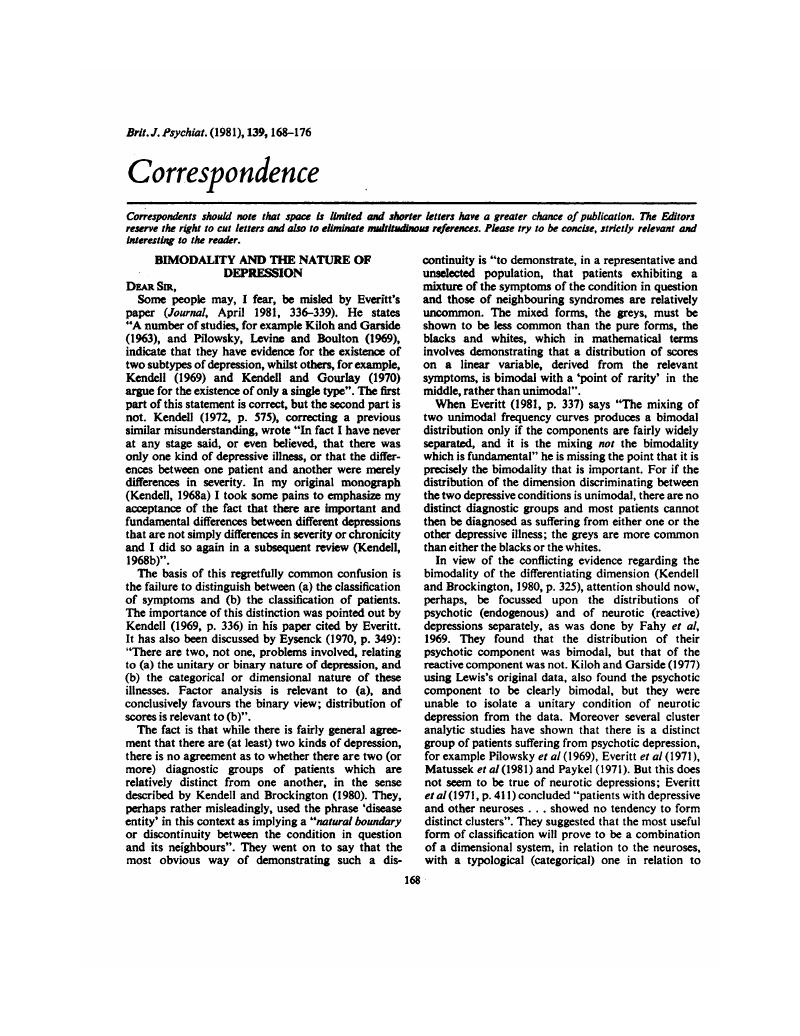No CrossRef data available.
Article contents
Bimodality and the Nature of Depression
Published online by Cambridge University Press: 29 January 2018
Abstract
An abstract is not available for this content so a preview has been provided. As you have access to this content, a full PDF is available via the ‘Save PDF’ action button.

- Type
- Correspondence
- Information
- Copyright
- Copyright © Royal College of Psychiatrists, 1981
References
Everitt, B. S. (1981) Bimodality and the nature of depression. British Journal of Psychiatry, 138, 336–9.Google Scholar
Everitt, B. S., Gourlay, A. J. & Kendell, R. E. (1971) An attempt at validation of traditional psychiatric syndromes by cluster analysis. British Journal of Psychiatry, 119, 399—412.Google Scholar
Eysenck, H. J. (1970) The classification of depressive illnesses. British Journal of Psychiatry, 117, 241–50.Google Scholar
Fahy, T. J., Brandon, S. & Garside, R. F. (1969) Clinical syndromes in a sample of depressed patients: a general practice material. Proceedings of the Royal Society of Medicine, 62, 331–5.Google Scholar
Garside, R. F. & Roth, M. (1978) Multivariate statistical methods and problems of classification in psychiatry. British Journal of Psychiatry, 133, 53—67.Google Scholar
Kendell, R. E. (1968a) The Classification of Depressive Illnesses.
London: Oxford University Press.Google Scholar
Kendell, R. E. (1968b) The problem of classification. In Recent Developments in Affective Disorders (eds. Coppen, A. and Walk, A.). pp 15—26. Ashford: Headley Brothers.Google Scholar
Kendell, R. E. (1969) The continuum model of depressive illness. Proceedings of the Royal Society of Medicine, 62, 335–9.Google Scholar
Kendell, R. E. (1976) The classification of depression: a review of contemporary confusion. British Journal of Psychiatry, 129, 15—28.Google Scholar
Kendell, R. E. (1972) Endogenous and neurotic depression. (Correspondence). British Journal of Psychiatry, 121, 575.Google Scholar
Kendell, R. E. & Brockington, I. F. (1980) The identification of disease entities and the relationship between schizophrenia and affective psychoses. British Journal of Psychiatry, 137, 324–31.Google Scholar
Kendell, R. E. & Gourlay, J. (1970) The clinical distinction between psychotic and neutoric depressions. British Journal of Psychiatry, 117, 257–60.Google Scholar
Kiloh, L. G., Andrews, B., Neilson, M. & Bianchi, S. N. (1972) The relationship of the syndromes called endogenous and neurotic depression. British Journal of Psychiatry, 121, 183–96.Google Scholar
Kiloh, L. G. & Garside, R. F. (1963) The independence of neurotic depression and endogenous depression. British Journal of Psychiatry, 109, 451–63.Google Scholar
Kiloh, L. G. & Garside, R. F. (1977) Depression: a multivariate study of Sir Aubrey Lewis's data on melancholia. Australian and New Zealand Journal of Psychiatry, 11, 149–55.Google Scholar
Matussek, P., Soldner, M. & Nagel, D. (1981) Identification of the endogenous depressive syndrome based on the symptoms and the characteristics of the course. British Journal of Psychiatry, 138, 361–72.Google Scholar
Paykel, E. S. (1971) Classification of depressed patients: a cluster analysis derived grouping. British Journal of Psychiatry, 118, 275–88.Google Scholar
Pilowsky, I., Levine, S. & Boulton, D. M. (1969) The classification of depression by numerical taxonomy. British Journal of Psychiatry, 115, 937–45.Google Scholar





eLetters
No eLetters have been published for this article.